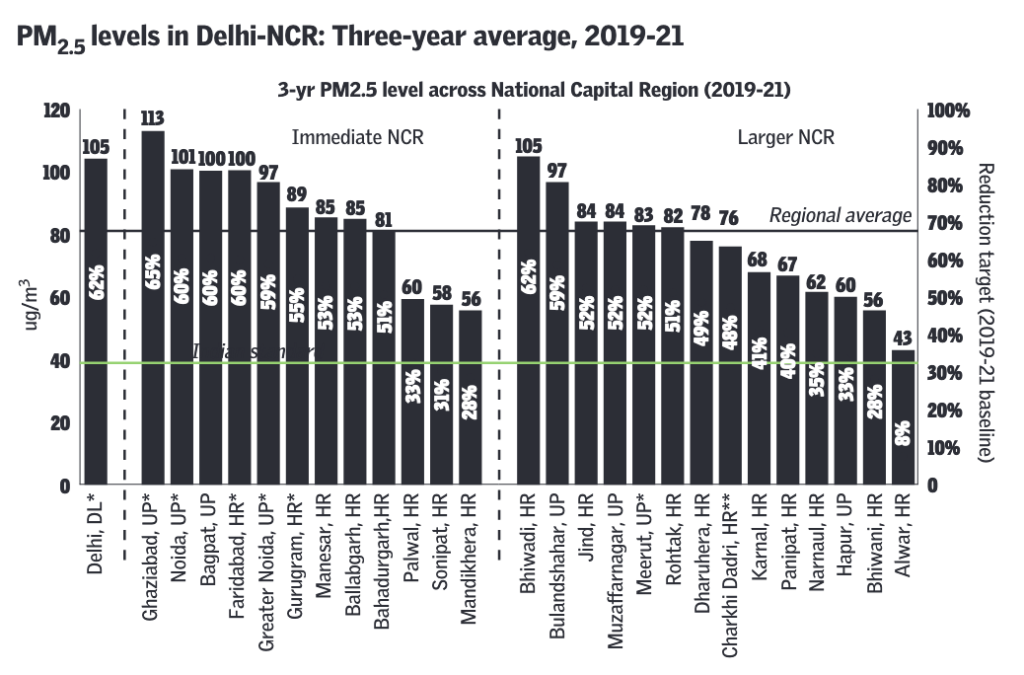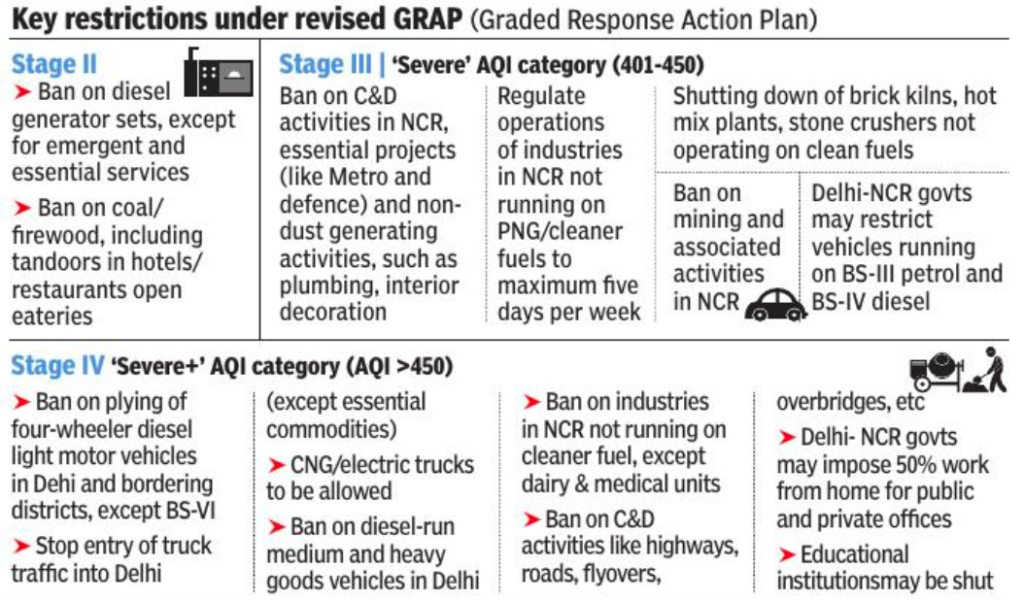ForumIAS announcing GS Foundation Program for UPSC CSE 2025-26 from 19 April. Click Here for more information.
Contents
| For 7PM Editorial Archives click HERE → |
Introduction
The Commission for Air Quality Management (CAQM) has announced a new policy to fight air pollution in Delhi-NCR (National Capital Region) over the next 5 years. It includes a revised Graded Response Action Plan (GRAP), among other short-term, medium-term and long-term measures. The release of policy was desired considering the deteriorating situation of air pollution levels in the Delhi NCR region. Experts believe the revamped policy will play a crucial role in encouraging states to take more proactive steps than merely relying on reactive measures.
What is the situation of air pollution in India?
According to WHO, of the 20 most polluted cities in the world, the top 14 are Indian cities. These include Kanpur, Faridabad, Varanasi, Delhi, etc.
The Environmental Performance Index (released by World Economic Forum) ranked India 178th out of 180 countries in terms of air quality.
| Read More: The Controversy Regarding Environment Performance Index – Explained, pointwise |
According to Central Pollution Control Board data, 11 most polluted cities in the country are from Uttar Pradesh. Ghaziabad is the most polluted city in the country followed by Gurugram.
Source: CAQM
| Read More: Air Quality Life Index (AQLI) – Explained, pointwise |
Commission for Air Quality Management (CAQM)
Graded Response Action Plan (GRAP)
Success of GRAP
|
Source: CAQM. Industrial Areas in Delhi NCR. NCR States include Rajasthan, Haryana and Uttar Pradesh.
What are the reasons behind deteriorating air quality in Delhi-NCR?
Air pollution become particularly severe and hazardous during the winter season:
Natural
Northwesterly Winds: Month of October marks the withdrawal of Monsoon winds (South-West) from North India, leading to the arrival of North-Easterly winds. The northwesterly winds bring-in dust from dust storms originating in Rajasthan, Pakistan and Afghanistan.
Wind speed: High wind speed in summers facilitates the faster movement of particulate matter in the air. As the wind speed decreases in winters, the air is not able to draw the pollutant away from a region.
Landlocked Geography of Delhi: Geography of Delhi and the northern plains is landlocked. While the source wind from North-West is already having pollutants; the Himalayas obstruct the escape route of air.
Anthropogenic
Industrial chimney wastes: There are a number of industries which are a source of pollution. The chief gases are SO2 and NO2. There are many food and fertilizers industries which emit acid vapours in air.
Automobiles pollution: Toxic vehicular exhausts are a source of considerable air pollution. In all the major cities of the country about 800 to 1000 tonnes of pollutants are being emitted into the air daily, of which 50% come from automobile exhausts.
Construction Activities: The rapid pace of development of roads, buildings and other physical infrastructure causes a significant degree of dust pollution.
Stubble Burning: Stubble Burning by farmers of neighboring States exacerbate the situation. The pollutants travel towards Delhi and become stationary over it due to low wind speed and calm conditions.
Source: CAQM. Sectoral contribution to PM2.5 pollution in the Delhi NCR. Although magnitude varies across studies, Transport, Industrial and Construction Sectors are the major contributors.
What are the provisions of the CAQM Policy?
Suggested revisions to the GRAP: Under the new GRAP for Delhi-NCR, there will be 4 different stages of adverse AQI: Stage I – Poor (AQI 201-300); Stage II – Very Poor (AQI 301-400); Stage III – Severe (AQI 401-450); and Stage IV – Severe Plus (AQI over 450).
Taking action based on the air quality index (AQI) and not the existing system of response that kicks in based on particulate matter concentrations.
Action taken when AQI is ‘very poor’, ‘severe’ or ‘severe+’ will be invoked ‘at least 3 days in advance of the AQI reaching the projected levels of that stage’ based on forecasts. Under the existing plan, action was initiated when pollution levels reached a certain threshold, and not in advance.
Ban on construction activities will set in when AQI is ‘severe’, and NCR State governments may impose restrictions on BS-III petrol and BS-IV diesel four-wheelers.
Under restrictions in the ‘severe+’ category, there is likely to be a ban on plying of 4-wheeler diesel light motor vehicles in Delhi and districts bordering Delhi, except for BS-VI vehicles and those used for essential or emergency services. Under this category, State Governments will decide on allowing 50% of staff to work from home in public, municipal and private offices. They may also consider additional measures like closure of educational institutions, and plying of vehicles on odd-even basis.
The previous plan did not have any specific restrictions on light motor vehicles, apart from enforcement of Pollution Under Control (PUC) norms, and odd-even for private vehicles.
Source: The Times of India
Clean Energy: The Ministry of Petroleum and Natural Gas (PNG), Ministry of Finance, and NCR State Governments could consider PNG under the ambit of lower slabs under the GST. This will ensure ‘uniform and affordable’ PNG pricing policy.
Air Quality Monitoring Network: While Delhi has a sufficient number of monitoring stations (50 out of 146 in the NCR), a plan of action is to be devised by the CPCB and State PCBs by July 31 to strengthen the monitoring network in other NCR districts.
Transport sector: The Ministry of Road Transport and Highways is to formulate norms for monitoring on-road vehicles with remote sensing devices for emissions surveillance by December 31 this year. The target for implementation of this remote monitoring mechanism in cities in the NCR is 25% of the planned network by December 2024, and 50% of the planned network by 2025.
The policy also recommends that NCR State Governments prepare a policy for retro fitment of vehicles to electric, and a system for collection of used batteries and engines for disposal by December this year.
Stubble Burning: It also stressed the need to upscale the use of the bio-decomposer solution to deal with paddy straw in the harvest season of 2022. The policy targets 60% of total paddy straw generated to be managed through in-situ and ex-situ measures by December 31, 2022, 80% by 2024, and 100% by 2026.
What is the significance of the new Policy?
First, placing PNG under a lower GST slab will ensure greater adoption vis-a-vis coal. This will reduce emission levels as PNG is less polluting than coal.
Second, it takes into consideration deficits in infrastructure and systems across the NCR sub-regions leading to variations in baseline actions. The targets are set keeping in mind regional variations and improvement potential.
Third, the focus on strengthening the quality of air pollution data. Filling the gaps through sensor-based monitoring to cover rural and peri-urban areas will help authorities take preventive measures.
Fourth, taking a multi-pollutant approach to control critical gases like nitrogen dioxide and ozone will help reduce exposure to toxic gases and control secondary particulate matter formation.
What lies ahead?
First, the success of policy depends on the degree of cooperation and coordination undertaken by specific Union and State organizations. Amongst all, cooperation between CAQM and CPCB is most essential for the success of the new policy.
Second, the State Governments of the NCR region must fill the critical infrastructure gaps that impede the implementation of policy measures. For instance, vehicle restraint measures are difficult to implement during smog episodes if the public transport infrastructure is inadequate in the region.
Third, the Environment Ministers of Delhi NCR region should meet at least once a month to effectively monitor the implementation of the new policy.
Fourth, apart from this, India must establish a national environment regulator just like SEBI (Stock Market regulator), RBI (Banking sector regulator) etc.
Conclusion
The policy is a step in the right direction to improve the worsening situation of air quality in the NCR region. However its success will truly depend on timely and effective implementation at the ground level. It is a measure that will help in providing the masses a clean and healthy environment which is sine qua non for a dignified living.
Syllabus: GS III; Conservation, environmental pollution and degradation.
Source: Indian Express, Hindustan Times, The Times of India, The Times of India









